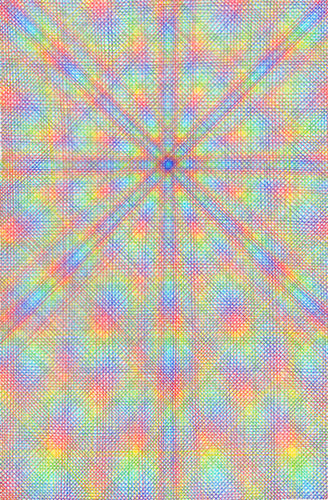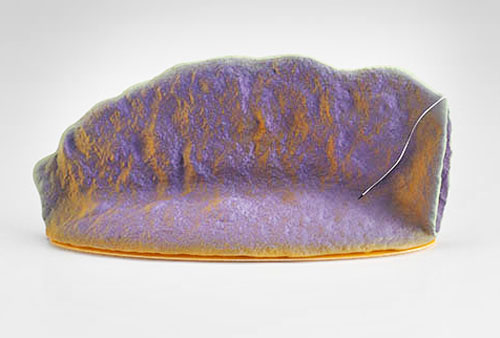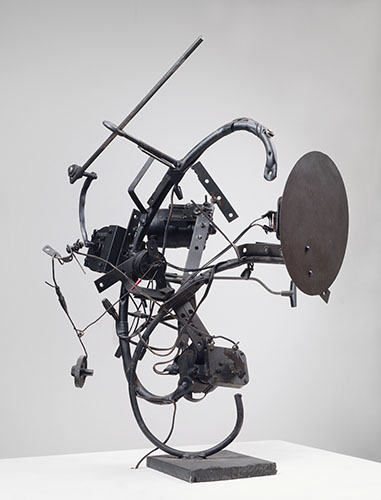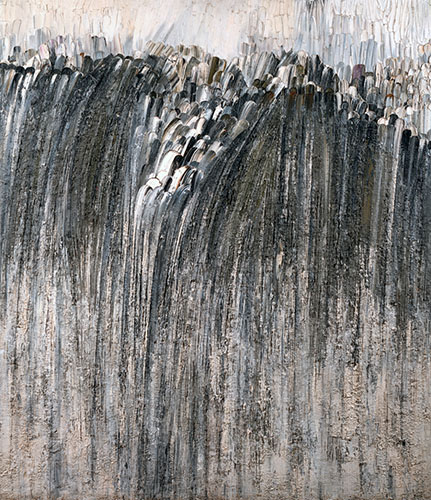 |
My prediction is that we are going to be seeing many more exhibitions like this one, which is essentially a presentation of works that a museum already owns operating under the guise of a curatorial “topic.” In this case, the aforementioned “topic” has two parts, the first being “abstraction” and the second being the distinction between “now” and “then.” Obviously, the “now” part looms large in our imaginations, because it is a code word for “the next new thing.” But in the case of this particular exhibition, the “then” part is surprisingly rich because it does a good job of rethinking the contemporary meaning of that term; in fact, it offers a much better rethinking than was the case with NY MOMA’s recent presentation of its own stupendous collection of Abstract Expressionist holdings.
 |
A similar failure of persuasive nowness is evidenced in the collection of 43 works on paper produced as a collaboration between Daniel Higgs and Kyle Ranson, which fails to rise beyond the status of being just another exercise in the making of surrealist exquisite corpse drawings. But nowness gets better after these wrong turns. Laurie Reid’s large untitled work from 1996 featuring a gossamer lattice of diluted red gestures spun on an expansive white field is pitch-perfect in its match of lyrical elegance and sumptuous materiality. Ditto for Ron Nagle’s collection of small sculptural works, which are surfaced with glowing iridescent dust. Xylor Jane uses the minimal means of pulsating colored lines on paper to get a maximal effect in a work from 2010 titled Pequod. If I were to pick one work in this exhibition’s Now section that most succeeds in fully carrying the burden of nowness, it would have to be Todd Bura’s Your Painting (2009), which is a modest oil on canvas work featuring a few well-placed clusters of thick dots. Like the more well-known work of Raoul De Keyser, Bura’s painting hides a canny examination of the historical relationships of the pictorial and the graphic behind the most unassuming arrangement of visual effects, creating an experience that is rigorously demanding and casually devil-may-care on the same surface.
 |
Jeremy Gilbert-Rolfe once said something very smart about the two lineages of abstract painting, noting that one evolves out of the attempt at pure opticality founded by the Impressionists; the other is an attempt at pure introspection founded by the Symbolists and significantly advanced by the Surrealists. Selz’s partisan art historical interests have always lined-up on the Symbolist side of this equation, no doubt having much to do with his own early years in close proximity with the historical European avant-garde. During his tenure at NY MOMA, those interests put him on the opposite side of an ideological fence from the one occupied by the highly influential Clement Greenberg, whose own formalist doctrine operated as a kind of historical apex of Gilbert-Rolfe’s first lineage.
 |
 |
But when we look at the Untitled Disc by Robert Irwin from 1969, or at Jay DeFeo’s Origin from 1956, we clearly see works by that deeply resonates with Symbolist derived subtexts that go a long way to re-frame and in fact re-invigorate the way that we understand the rather complicated story of how American art embraced abstraction during the 1960s. It is a story that is worth remembering, now that a new generation of abstract art is preparing to take its place in the art world’s fickle limelight. This is because, if the new generation of abstract artists are going to accomplish anything more than mark a fleeting moment of art world fashion, they are going to have to figure out how to make some kind of third path that restages and reinvents the dialog between Symbolist and optical imperatives; this in recognition of the fact that the unavoidable subject matter of all serious abstract art is nothing less than the conscious relationship that it establishes with the history of abstract art.
–MARK VAN PROYEN
Abstraction: Now and Then @ Berkeley Art Museum, through April 17, 2011
Mark Van Proyen is Chair of the Painting Department of the San Francisco Art Institute. He is currently working on a Novel titled "Theda’s Island," the story of which taking place in the art world.
In customary rapid-fire staccato style, MVP announces the forward march of abstract art, as evidenced by the Berkeley Art Museums’ “Abstraction: Then and Now” exhibit and also cautions the new wave of abstract artists to seize the dialog between “Symbolist and optical imperatives” to avoid the “art world’s fickle limelight.” Sage advice from the master observer.
Nice piece on BAM’s show, done with the pith and verve we associate with the Van Proyen brand!
Seriously, yes, we will undoubtedly be seeing more “buried treasure” shows in the future, given museums’ shrinking budgets, as well as more corporate branding of gold from the permanent collections. The New Yorker magazine’s mining of its cartoon history for jigsaw puzzle material comes to mind in the latter case. Can the “Whistler’s Mother whistles” from the movie “Bean” be far off?
Current critical theory, as I understand (or misunderstand) it, supports such recycling, its tough talk of social critique masking its de facto subservience to—guess what—capitalist trafficking in artifacts, holy or unholy.